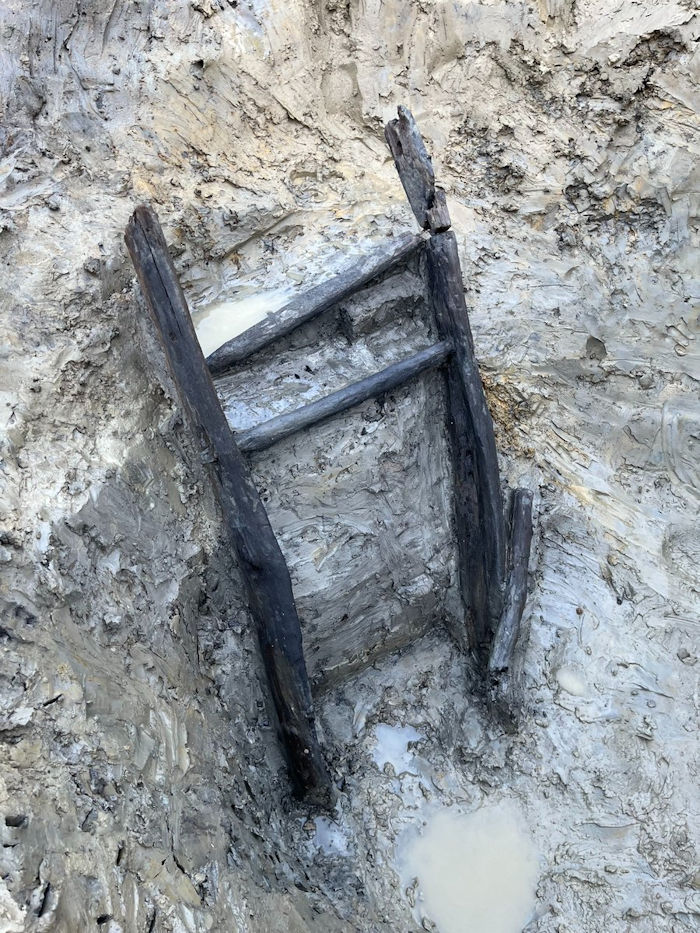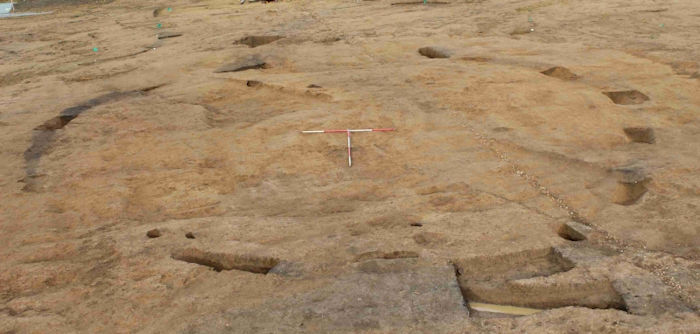Conny Waters – AncientPages.com – Archaeologists in the UK have made many fascinating discoveries while excavating at a site known as Field 44 near the village of Tempsford in Central Bedfordshire.
Some weeks ago, archaeologists working in the area announced the remains of a Roman malting oven that could be the earliest physical evidence for beer-making in the UK, dating back more than 2,000 years to the Iron Age. Evidence of early Iron Age porridge and bread-making has also been uncovered.

This 1,000-year-old wooden ladder has been unearthed in the UK. Credit: MOLA
In recent days MOLA archaeologists have unearthed an incredibly, well-preserved 1,000-year-old wooden ladder.
According to the MOLA scientists, the ladder was found in a well, where water and mud preserved the wood for 1,000s of years! Preliminary reports state the ladder comes from a cluster of watering holes dated to the Middle Iron Age (c.300-100 BC). In the vicinity archaeologists also found Roman artifacts and evidence of an ancient farm that has offered an incredible glimpse through time to see how life has changed over the last 6,000 years.
The farm’s story spans across a 700-year period from Middle Iron Age to the Roman conquest and beyond. Well before the farmstead existed, people were already visiting this area. Although no evidence of where they lived has been found, they left behind signs of their activities.
Flint arrowheads were discovered dating back to the Neolithic (c. 4000-2200 BC) and Bronze Age (c. 2600-700 BC), suggesting people were hunting animals in the surrounding landscape well before the farmstead existed.
The first evidence of a settlement is from the Middle Iron Age (c. 300-100 BC), with the unearthing of two large round houses dating back to that period. They measure more than 15 meters in diameter and contain evidence of the remains of butchered animals, pottery, loom weights, and personal items. This shows that people both lived and worked in them.

The remains of the northern roundhouse, showing its shape and size. Credit: MOLA
After the Roman conquest in AD 43, there is evidence, that the settlement expanded and continued to be occupied for around 400 years. During this time, farming was an important activity at this settlement.
This is proved by the discovery of an oven used to dry grains and make malt for brewing, as well as by the querns (simple hand mills for grinding grains) and cereals found on site.
See also: More Archaeology News
However, this was also a place where goods were being produced and traded. Archaeologists have identified a Roman pottery kiln with a vast number of wasters (pots which failed during the firing process). Moreover, a number of higher-status small finds have also been uncovered, beyond what is expected of a typical farmstead in this part of the country. Together these discoveries show the growing wealth and importance of the settlement.
“These early excavations suggested that the site had a long and complex history, which is now being revealed,” MOLA archaeologists say.
Written by Conny Waters – AncientPages.com Staff Writer





